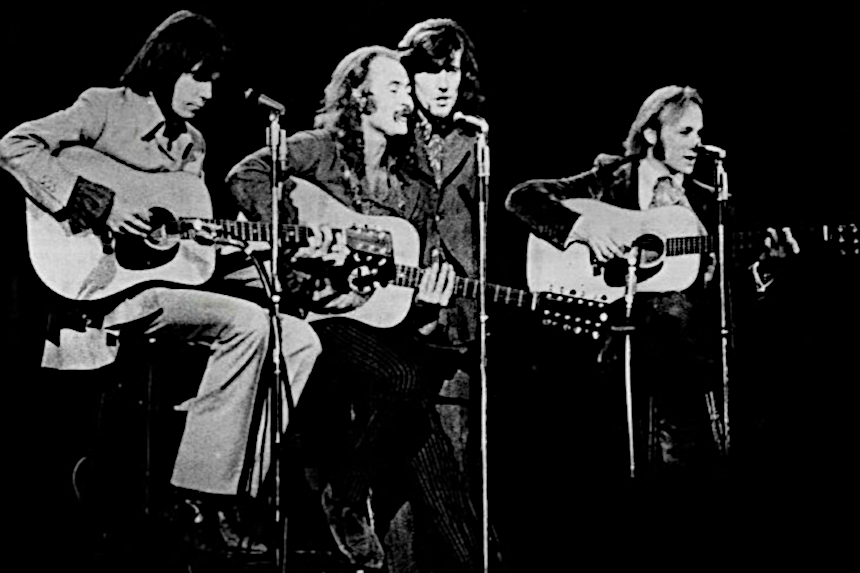They come together like musical Avengers; prominent rock heroes in their own right, they realize the power that they have as a unit. That’s why they’re called supergroups, an assemblage of pro talent that combines into something bigger. This week marks 50 years since one of the biggest supergroups, Crosby Stills & Nash, released their first album. Here’s a look at some of the biggest and what made them special.
1. Cream
“White Room” by Cream (Uploaded to YouTube by Cream / Universal Music Group)
Rolling Stone editor Jann Wenner calls Cream the first supergroup, so we won’t argue. The band formed when bassist Jack Bruce and drummer Ginger Baker (both of the Graham Bond Organisation) and guitar legend Eric Clapton joined forces in 1966. Clapton could be considered a supergroup rainmaker, as he’s played with not only Cream, but also the Plastic Ono Band, Derek & The Dominos, Blind Faith, The Yardbirds, John Mayall and the Bluesbreakers, The Dirty Mac, and more. Cream is notable, among other things, for having the world’s first platinum double-album (Wheels of Fire), their almost scholarly injection of blues into hard rock, and for selling out four 2005 reunion shows at London’s Royal Albert Hall in under an hour.
2. Crosby, Stills & Nash (and Young)
“Southern Cross” by Crosby, Stills & Nash (Uploaded to YouTube by Crosby, Stills & Nash / Rhino)
Rather than give the group its own unique name, CSN used everyone’s last names so that they would never be the full band without each other. They officially formed in 1968, but their eponymous first album/mission statement arrived on May 29, 1969. David Crosby had originally been in The Byrds, whereas Stephen Stills came from Buffalo Springfield and Graham Nash hailed from The Hollies. CSN emphasized tight, beautiful harmonies and thoughtful songwriting. Neil Young (also of Springfield) would join in 1969 and play off and on with the group for years. As of 2017, various members have commented that they won’t play together again, but the one constant in their history remains unexpected reunions and tours.
3. Led Zeppelin
Led Zeppelin doing “Immigrant Song” live in 1972 (Uploaded to YouTube by Led Zeppelin)
Jimmy Page was one of three guitar heroes from The Yardbirds (the others being Clapton and Jeff Beck). When he set out to create his own group, he brought in the well-regarded multi-instrumentalist session player John Paul Jones to fill out the bass. They found their singer and drummer in two young men from the Band of Joy, Robert Plant and John Bonham. What followed was nothing less than the redefinition of rock. Standing at the crossroads of blues and metal and powered by the virtuosity of all four members, Zeppelin released anthem after anthem from their 1968 inception until their 1980 dissolution after Bonham’s untimely death. Today, the three surviving members occasionally reunite, and their songs are staples of film soundtracks and classic rock radio.
4. Bad Company
Bad Company performing “Movin’ On” live at Wembley Stadium in 2010 (Uploaded to YouTube by MUSIC FOR YOU)
Led Zeppelin’s Swan Song label signed Bad Company in 1973. The band originally consisted of former Mott the Hoople guitarist Mick Ralphs, former King Crimson bassist Boz Burrell, and two members of Free: drummer Simon Kirke and vocalist Paul Rodgers. Rodgers was one of the big selling points of the group, as he is frequently listed among the best rock singers ever. Between 1974 and 1976, they released three Top 5 albums and a series of singles that have become classic rock staples. The band has split and recombined a number of times over the decades, but Kirke and Rodgers (despite stints with The Firm, Queen, and others) remain members of the touring configuration of the band.
5. The Power Station
The video for “Some Like It Hot.” (Uploaded to YouTube by Duran Duran / Rhino)
When you’re in one of the biggest bands in the world and your band goes on a break, you . . . form another band? That’s what guitarist Andy Taylor and bassist John Taylor (no relation) of Duran Duran did in 1984. Teaming up with vocalist Robert Palmer and Chic drummer Tony Thompson, they put together The Power Station, named after the Manhattan recording studio. The band had two hit singles almost immediately with “Some Like It Hot” and their cover of T-Rex’s “Get It On (Bang a Gong).” However, Palmer exited fairly quickly, and was replaced by Michael Des Barres, who fronted the band at Live-Aid in 1985. They scattered shortly thereafter, with Des Barres notably playing the recurring role of arch-nemesis Murdoc on MacGyver. The original line-up got back together in the ’90s with chic bassist Bernard Edwards filling in for John Taylor. The band broke up for good after their last tour in 1997.
6. Trio
The “Trio” “After the Gold Rush (Uploaded to YouTube by Warner Music Nashville)
Colloquially called Trio as it was the name of their first studio collaboration, the group of Dolly Parton, Linda Ronstadt, and Emmylou Harris teamed up for the simplest of reasons: they’re friends. They tried to collaborate in the ’70s, but schedules never aligned; nevertheless, the three spent the next several years covering each other’s songs in various configurations. They finally got together and put out Trio in 1987; it was an instant success, generating four hit singles and sales of over 4 million albums. The disc won a number of country awards and was even up for the Grammy for Album of the Year opposite Whitney Houston, Michael Jackson, Prince, and U2. A follow-up, Trio II, was recorded in 1994, but label politics delayed its release until 1999. A third volume that combines the first two records with outtakes and rarities was released in 2016.
7. The Traveling Wilburys
“Handle With Care” by The Traveling Wilburys (Uploaded to YouTube by TravelingWilburys)
Speaking of groups that form out of friendship . . . while George Harrison (do we really need to say “of The Beatles”?) was recording his 1987 album Cloud Nine with producer Jeff Lynne of ELO, Harrison forwarded the idea of assembling a group. Harrison decided to invite Bob Dylan, while Lynne opted for another legend, Roy Orbison. Dylan introduced the others to Tom Petty, with whom he’d toured. The five musicians got along famously and soon conceived of a group name based partially on a joke of “burying” one another’s mistakes in the song mixing process. The first album, Traveling Wilburys Vol. 1, was released in 1988 and produced two big hit singles in “Handle with Care” and “End of the Line.” Unfortunately, Orbison passed before the release of the second single; the video for “Line” contains a tribute to him in the form of a shot of a guitar in a rocking chair and a framed photo during his verse. The remaining members would release a second album, Traveling Wilburys Vol. 3 (yes, 3) and a boxed set two years after Harrison passed in 2001.
8. Foo Fighters
Foo Fighters perform “Walk” on a special black-and-white episode of Live on Letterman in 2011. (Uploaded to YouTube by Foo Fighters)
When Nirvana ended with Kurt Cobain’s death in 1994, drummer Dave Grohl retreated from music for many months before creating a demo of his own material on which he sang and played all of the instruments. He labeled it as being performed by Foo Fighters even though he didn’t have a band yet. Over the next few months, Grohl did form a band, bringing ex-Germ Pat Smear, who had also played second guitar on Nirvana tours. The rhythm section was originally composed of bassist Nate Mendel and drummer William Goldsmith from Sunny Day Real Estate. The eponymous album dropped in 1995 and the band took off, powered by infectious tunes and clever videos. Goldsmith left and was replaced by Alanis Morissette’s drummer, Taylor Hawkins. The band’s second album, The Colour and The Shape, marked them as major rock artists; the record charted in the Top 10, received a Grammy nomination, and contained three legit classic tracks in “Everlong,” “Monkey Wrench,” and “My Hero.” The band only got bigger from there; Smear departed for a bit, replaced by Franz Stahl, but would eventually rejoin alongside another guitar player, Chris Shiflett (of Me First and The Gimme Gimmes), who joined with the band by their fourth record. Longtime touring keyboardist Rami Jaffee, originally of The Wallflowers, was made a full member of the band in 2017 after 12 years with the group. Today, Grohl, Smear, Mendel, Hawkins, Shiflett, and Jaffee operate as rock royalty. As one of the most successful and consistent touring acts in rock, they’ve won 11 Grammys in various categories, including four for Best Rock Album. They hit the road again this summer.
Featured Image: Crosby, Stills, Nash & Young (Photo by CMA-Creative Management Associates/Atlantic Records; Wikimedia Commons)
Become a Saturday Evening Post member and enjoy unlimited access. Subscribe now




Comments
Agreed – except you forgot Dave Brubeck!
Yeah, some of this I listened to in the late 60s – early 70s, when I was a teenager. Really, only C,S,N and C,S,N, and Y matter a damn. The rest is music for the immature. Thank God I discovered jazz and big band in the late 70s; if you’re looking for true supergroups, look to any of the bands fronted by Louis Armstrong, Bix Beiderbecke, Artie Shaw, Duke Ellington, Benny Goodman, Eddie Condon, Charlie Parker, Miles Davis, Art Blakey, ad gloriam, my good if undereducated man.